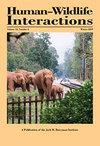城市里的红狐会攻击人吗?英国事件的探索性研究与回顾
IF 0.9
4区 环境科学与生态学
Q4 BIODIVERSITY CONSERVATION
引用次数: 3
摘要
人类与野生动物的互动被认为在世界范围内正在增加,许多研究分析了大型食肉动物带来的风险。然而,人们也会将小型食肉动物视为威胁,尤其是在城市地区。红狐(Vulpes Vulpes)在20世纪30年代开始在英国城市殖民,公众越来越担心狐狸咬人,尤其是咬婴儿。这些事件通常被媒体描述为攻击,并产生了大量的媒体报道和猜测,即狐狸将人类婴儿视为潜在的猎物。由于狐狸主要依靠听觉线索进行狩猎,我们于2015年12月和2016年5月至6月在英国布里斯托尔西北部的15个住宅花园和11个花园进行了声学回放实验,以确定城市狐狸是否会被婴儿的求救信号(哭声)所吸引。相比于沉默,狐狸更容易被婴儿的哭声或笑声所吸引,尽管少数狐狸会谨慎地接近并接触婴儿这两种声音的来源。它们的行为似乎是调查性的,而不是攻击性或掠夺性的。我们对英国媒体报道的事件进行了回顾,发现大多数人在睡觉时被咬伤或抓伤,成年人比儿童更容易被咬伤。相互作用的性质和造成的伤口表明,狐狸正在使用它们的嘴或前脚来调查一个不寻常的物体。大多数事件发生在人们的家中,尽管狐狸很少进入房屋。数据表明,人们被咬伤的事件是偶然事件,可能与一只特别大胆的狐狸有关。为了最大限度地减少对公众的风险,需要更多关于进入房屋和咬人的狐狸的年龄、社会地位和健康状况的定量数据。本文章由计算机程序翻译,如有差异,请以英文原文为准。
Do Urban Red Foxes Attack People? An Exploratory Study and Review of Incidents in Britain
Human–wildlife interactions are believed to be increasing worldwide, and a number of studies have analyzed the risks posed by larger carnivores. However, people can also perceive smaller species of carnivores as threatening, particularly in urban areas. Red foxes (Vulpes vulpes) started to colonize British cities in the 1930s, and there is growing public concern about foxes biting people, particularly babies. These events are generally described in the press as attacks and generate intense media coverage and speculation that foxes view human infants as potential prey. Because foxes rely primarily on auditory cues for hunting, we conducted acoustic playback experiments in the gardens of 15 residential houses in northwest Bristol, United Kingdom, in December 2015 and 11 gardens from May to June 2016 to determine whether urban foxes were attracted to infant distress calls (cries). Foxes were not more likely to be attracted to infant cries or laughs than silence, although a minority of foxes cautiously approached and contacted the source of both types of infant vocalization. Their behavior appeared to be investigative rather than aggressive or predatory. Our review of the incidents reported in the British media showed that most people were bitten or scratched while sleeping, and adults were more likely to be bitten than children. The nature of the interactions and the wounds inflicted suggest that the foxes were using their mouth or forefeet to investigate an unusual object. Most incidents occurred inside people’s homes, even though it is unusual for foxes to enter houses. The data suggested that incidents where people were bitten were chance events, possibly involving a particularly bold fox. To minimize the risk to the public, more quantitative data are required on the age, social status, and health of the foxes that enter houses and those that bite people.
求助全文
通过发布文献求助,成功后即可免费获取论文全文。
去求助
来源期刊

Human–Wildlife Interactions
Environmental Science-Nature and Landscape Conservation
CiteScore
2.80
自引率
0.00%
发文量
0
审稿时长
11 weeks
期刊介绍:
Human–Wildlife Interactions (HWI) serves the professional needs of the wildlife biologist and manager in the arena of human–wildlife conflicts/interactions, wildlife damage management, and contemporary wildlife management. The intent of HWI is to publish original contributions on all aspects of contemporary wildlife management and human–wildlife interactions with an emphasis on scientific research and management case studies that identify and report innovative conservation strategies, technologies, tools, and partnerships that can enhance human–wildlife interactions by mitigating human–wildlife conflicts through direct and indirect management of wildlife and increased stakeholder engagement. Our intent is to promote a dialogue among wildlife professionals concerning contemporary management issues. As such, we hope to provide a repository for wildlife management science and case studies that document and share manager experiences and lessons learned.
 求助内容:
求助内容: 应助结果提醒方式:
应助结果提醒方式:


